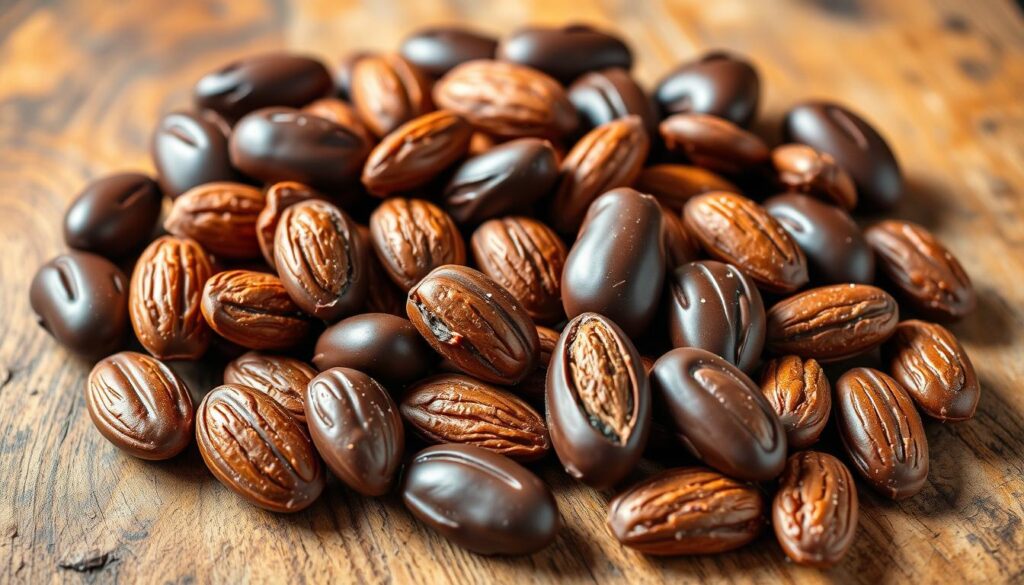Have you ever wondered about the classification of chocolate almonds? The debate on whether they are candy is complex and intriguing. It affects not just chocolate almonds but the whole confectionery industry. Knowing where they stand can help us appreciate the effort that goes into making them.
Related : Delicious Chocolate Covered Almonds: A Sweet Treat

The classification of candy is a nuanced topic, encompassing factors such as ingredients, production methods, and nutritional value. When it comes to chocolate-covered almonds, the question of whether they qualify as candy is far from straightforward. Delving into their classification requires a deeper exploration of what defines candy and how chocolate almonds fit into this category. With the growing popularity of gourmet chocolate almonds, the line between candy and other types of food has become increasingly blurred, adding complexity to the discussion.
Key Takeaways
- Chocolate covered almonds are a popular treat that raises questions about candy classification
- The classification of chocolate almonds as candy depends on various factors, including ingredients and processing methods
- Understanding candy classification can help appreciate the craftsmanship behind chocolate covered almonds
- Chocolate almonds have a unique nutritional profile that sets them apart from traditional candy types
- The debate around are chocolate covered almonds considered candy? is ongoing and influenced by industry trends and consumer perceptions
- Exploring the world of chocolate almonds can provide insight into the complexities of candy classification
Understanding the Basic Classification of Chocolate Covered Almonds
Exploring sweet snacks means knowing how treats are grouped. Their classification depends on certain traits and definitions.

Traditional Definition of Candy
Candy is often associated with sweetness, indulgence, and a delightful, sugar-packed flavor. It includes a diverse range of treats, such as gummies, hard candies, and chocolates. The concept of candy revolves around its primary ingredients and the processes that turn them into enjoyable, irresistibly sweet confections, appealing to people of all ages and tastes.
Where Chocolate Covered Almonds Fit In
Chocolate covered almonds mix candy and nuts, creating a special treat. They have chocolate’s sweetness and almonds’ crunch and protein. This mix makes them both sweet and a bit healthier.
The Grey Area of Confectionery Classification
Classifying treats like chocolate covered almonds is tricky. They share candy traits but also have nuts, making them a mix of snacks and healthier options. This ambiguity shows how confectionery categories are changing.
| Criteria | Traditional Candy | Chocolate Covered Almonds |
|---|---|---|
| Sugar Content | High | Moderate |
| Main Ingredients | Sugar, flavorings | Chocolate, almonds |
| Texture | Varies from soft to hard | Crisp and crunchy |
| Perceived Healthiness | Treat or indulgence | Slightly healthier due to nuts |
The Manufacturing Process Behind Your Chocolate Covered Almonds
Your journey to savoring mouthwatering chocolate treats starts with selecting the finest almonds. Only the highest-quality nuts are chosen, ensuring exceptional taste and premium quality in every bite.
Once selected, the almonds undergo a careful roasting process. This step enhances their natural flavors, bringing out a rich, nutty essence that serves as the perfect foundation for creating irresistible sweet confections.
- Roasting: The almonds are roasted to bring out their rich taste.
- Cooling: After roasting, they are cooled to maintain crunchiness.
- Coating: High-quality chocolate is melted and carefully coated onto each almond.
- Packaging: Lastly, the chocolate treats are packaged to keep them fresh and flavorful.
The whole process is crafted to keep both the almonds and chocolate at their best. This results in a perfect mix that fulfills your sweet tooth.

| Step | Description |
|---|---|
| Roasting | Enhances the natural flavor of almonds. |
| Cooling | Maintains the desired crunchiness. |
| Coating | Applies a rich layer of high-quality chocolate. |
| Packaging | Ensures freshness and preserves flavor. |
Comparing Chocolate Covered Almonds to Traditional Candy Types
When we compare chocolate almonds to traditional candies, we look at ingredients, how they’re made, and how long they last. These things help us understand what makes each snack special and how people see them.
Ingredient Composition Analysis
Chocolate almonds mix nuts with top-notch chocolate. This gives them proteins and healthy fats. On the other hand, traditional candies are mostly sugar and artificial stuff. They give a quick energy boost but don’t have much nutritional value.
Processing Methods Comparison
Making chocolate almonds involves roasting almonds and covering them in chocolate. This creates a perfect mix of flavors. Traditional candies, though, are made by heating sugar a lot and adding special ingredients to get the right taste and texture.
Shelf Life and Storage Requirements
Chocolate almonds last longer because of the nuts, which stay good when stored right. Traditional candies need to be kept in a cool, dry place to avoid melting or getting grainy. This makes them not last as long as chocolate almonds.
| Aspect | Chocolate Almonds | Traditional Candy |
|---|---|---|
| Ingredients | Nuts, Quality Chocolate | Sugar, Artificial Flavors |
| Nutrition | High in Protein and Healthy Fats | High in Sugar |
| Processing | Roasting and Coating | Sugar Heating and Additives |
| Shelf Life | Longer, if stored properly | Shorter, sensitive to storage conditions |
Are Chocolate Covered Almonds Considered Candy? The Technical Perspective
You might wonder are chocolate covered almonds considered candy? From a technical standpoint, it depends on certain criteria. Food scientists and regulatory bodies set these standards.
Food scientists look at ingredients, how they’re made, and when we eat them. Regulatory agencies check labels and nutrition to decide what’s candy.
- Ingredient Composition: The balance of sugar, fat, and other ingredients.
- Processing Methods: Techniques used in manufacturing, such as coating and tempering.
- Consumption Occasions: Whether the product is meant as a snack or a treat.
Chocolate covered almonds have traits of both candy and snacks. The debate is whether they’re more like candies or healthier snacks because of chocolate and sugar.
Knowing these details helps us understand where chocolate covered almonds stand. They add to the ongoing confectionery debate.
Nutritional Profile: More Than Just a Sweet Treat
Choosing chocolate treats like chocolate covered almonds is more than a sweet indulgence. These treats offer a balanced mix of nutrients, unlike regular candy.
Protein and Healthy Fat Content
Chocolate covered almonds are packed with protein and healthy fats. A serving has about 6 grams of protein and 14 grams of fats, mostly from almonds. This helps keep muscles strong and supports heart health.
Sugar and Calorie Comparison
Unlike traditional candy, nutty sweets like chocolate covered almonds have less sugar and calories. A serving has around 12 grams of sugar and 170 calories. This is less than the 30 grams of sugar and 200 calories found in many candies. So, they’re a better choice for those watching their sugar intake.
Health Benefits vs. Traditional Candy
Opting for chocolate covered almonds over regular candy has health perks. Dark chocolate’s antioxidants and almonds’ fiber aid digestion and reduce inflammation. They also contain magnesium and vitamin E, boosting overall health. This makes them a healthier treat option.
| Nutrient | Chocolate Covered Almonds | Traditional Candy |
|---|---|---|
| Protein | 6g | 1g |
| Healthy Fats | 14g | 0g |
| Sugar | 12g | 30g |
| Calories | 170 | 200 |
Regulatory Classification and Labeling Requirements
Regulatory bodies play a crucial role in determining how candy is classified. For instance, you might wonder, are chocolate-covered almonds considered candy? The answer largely depends on guidelines set by the FDA.
The FDA categorizes food products by examining their ingredients and manufacturing processes. According to these guidelines, chocolate-covered almonds are generally classified as confectionery items, grouping them with many other types of candy. These regulations are designed to ensure product safety, proper labeling, and consistent quality across the board, helping consumers make informed choices.
Like regular candy, chocolate-covered almonds are required to meet specific labeling standards, including:
- Ingredient List: A clear and complete list of all ingredients used in the product.
- Nutritional Information: Comprehensive details about calories, fats, sugars, and other nutrients.
- Allergen Declarations: Warnings about potential allergens, such as nuts, dairy, or soy.
These requirements not only help consumers make informed choices but also maintain product standards across the industry.
The classification of chocolate-covered almonds highlights the nuanced nature of candy categorization. While the FDA considers them a confectionery item, the perception of whether they are “candy” can vary depending on personal or cultural perspectives. This complexity underscores the importance of regulatory standards in shaping our understanding of food products.
Cultural Perspectives on Chocolate Covered Almonds
Exploring how different cultures perceive chocolate-covered almonds reveals diverse ways of enjoying this treat. Understanding these perspectives not only highlights the versatility of chocolate almonds but also adds depth to the ongoing discussion about what defines sweets and snacks across various traditions.
Global Consumption Patterns
Chocolate almonds are loved all over the world, but their popularity changes by place. In Europe, they’re seen as fancy sweets. In Asia, they’re part of old-fashioned candies. In North America, they’re a favorite for quick treats.
Regional Classification Differences
How chocolate almonds are seen changes with culture. In the U.S., they’re just sweet snacks. But in some European places, they’re more like fancy candies. This shows how local tastes shape our views on sweets.
| Region | Classification | Consumption Pattern |
|---|---|---|
| North America | Sweet Snacks | Commonly found in candy stores and supermarkets |
| Europe | Gourmet Confectionery | Often marketed as premium treats |
| Asia | Traditional Confectionery | Integrated into local sweets and desserts |
Marketing and Retail Placement: Where You’ll Find Them
When you’re looking for chocolate treats, where they’re placed matters a lot. Knowing where to find them can make your shopping better. It helps you pick the best nutty sweets for you.
Store Placement Analysis
Chocolate covered almonds are put in different spots in stores to reach more people:
- Candy Aisles: They’re placed with other sweets to show they’re a treat.
- Snack Sections: They’re with healthier snacks to show they’re good for you.
- Checkout Counters: They’re there for people who want something quick.
Consumer Perception Impact
Where chocolate covered almonds are placed changes how people see them. Near other candies, they’re just a sweet treat. But with healthy snacks, they’re seen as a good mix of taste and nutrition.
| Store Section | Perception as Candy | Perception as Snack |
|---|---|---|
| Candy Aisle | High indulgence | Low nutritional focus |
| Snack Section | Moderate indulgence | High nutritional value |
| Checkout Counter | Impulse purchase | Quick snack option |
Conclusion: The Sweet Truth About Chocolate Covered Almonds
You’ve looked into whether chocolate covered almonds are candy. You’ve learned about candy classification and their health benefits. It’s clear they have a special place in the world of sweets.
Chocolate almonds are like candy but have nuts and more protein. Rules don’t always make it clear if they’re candy. This makes the debate ongoing.
How people see chocolate almonds varies by region. It depends on local tastes and how they’re eaten. In stores, they’re seen as both healthy snacks and sweets.
This means you can enjoy them for their sweetness and get some health benefits. Companies can reach more people by making treats that are both tasty and good for you.
The world of sweets is changing. Chocolate covered almonds are a good example of this. By knowing more about them, you can enjoy your favorite snacks even more.
FAQ
Are chocolate covered almonds considered candy?
Yes, chocolate covered almonds are often seen as candy. They have a sweet chocolate coating and crunchy almonds. But, some think they’re between candy and nuts because of the almonds.
How do chocolate covered almonds fit into the overall candy classification?
Chocolate covered almonds are a type of chocolate treat. They mix chocolate’s rich taste with almonds’ natural flavor. This makes them a part of the sweet snack category.
What factors contribute to the debate on whether chocolate covered almonds are candy?
The debate about chocolate covered almonds as candy focuses on their ingredients and health benefits. They have sugar and chocolate like regular candies. But, they also have almonds, which add protein and healthy fats.
Can chocolate covered almonds be classified as a healthy alternative to traditional candy?
Yes, chocolate covered almonds are seen as a healthier choice than regular candy. They offer protein and healthy fats from almonds, along with chocolate’s sweetness. This makes them a better option for a sweet snack.
How do regulatory bodies classify chocolate covered almonds?
Regulatory bodies classify chocolate covered almonds as candy. They look at both the chocolate and almond parts when deciding on labels and standards.
In what ways do cultural perspectives influence the classification of chocolate covered almonds as candy?
Cultural perspectives play a significant role in how chocolate-covered almonds are perceived. In some regions, they are simply considered candy due to their sweet, chocolate coating. However, in other cultures, the presence of almonds shifts their identity toward being a nut-based snack, valued for its perceived nutritional benefits. This variation highlights how cultural views influence the classification and perception of food items.
Where are chocolate covered almonds typically placed in retail stores?
You can find chocolate covered almonds in the candy section or with other nutty sweets. Their spot in stores can shape how people see them, as both candy and a healthier snack.
What is the manufacturing process of chocolate covered almonds compared to other candies?
Making chocolate covered almonds involves picking quality almonds and coating them in chocolate. This process is different from other candies, showing why they stand out in the candy world.

